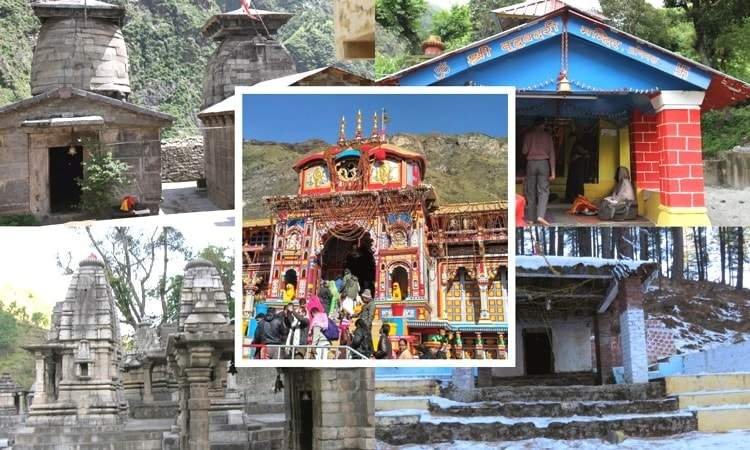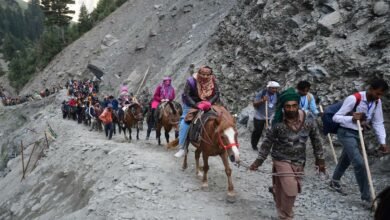Panch Badri Temples of Uttarakhand

The Panch Badri of Uttarakhand refers to a group of five sacred Hindu temples dedicated to Lord Vishnu, located in the Garhwal region of the Indian state of Uttarakhand. These temples hold immense religious significance for Hindus and are an integral part of the Char Dham pilgrimage circuit. Let’s explore each of these temples in detail:
1. Badrinath Temple
Location and Significance: Badrinath Temple is situated in the town of Badrinath in the Chamoli district of Uttarakhand, nestled amidst the majestic Himalayan ranges. It holds immense significance in Hindu mythology and is one of the holiest pilgrimage sites for Hindus. The temple is dedicated to Lord Vishnu, specifically in his form as Badrinarayan.
Mythological Significance: According to Hindu mythology, Badrinath is part of the Char Dham pilgrimage circuit and is considered one of the 108 Divya Desams, sacred abodes of Lord Vishnu. It is believed that Lord Vishnu meditated here for thousands of years under a Badri tree. The name “Badrinath” itself is derived from the word “Badri,” which refers to the wild berries that grow abundantly in the region.
Architecture and Features: The architecture of the Badrinath Temple is a fine example of traditional North Indian temple architecture. The main sanctum sanctorum houses the idol of Lord Badrinarayan, along with idols of other deities like Goddess Lakshmi, Lord Narasimha, and Garuda. The temple’s exterior is adorned with intricate carvings depicting various mythological scenes and motifs.
One of the unique features of Badrinath Temple is the Tapt Kund, a natural thermal spring located just below the temple. Devotees believe that taking a dip in the holy waters of Tapt Kund before visiting the temple purifies the soul.
2. Yogadhyan Badri
Location and Significance: Yogadhyan Badri is located in Pandukeshwar village, approximately 24 kilometers from Badrinath. It is the second temple in the Panch Badri circuit and holds a special place in Hindu mythology.
Mythological Significance: Legend has it that Pandu, the father of the Pandavas from the Mahabharata, meditated at Yogadhyan Badri. The name “Yogadhyan” signifies a place of meditation. It is believed that Pandu came to this serene location to seek penance and spiritual solace.
Architecture and Surroundings: Yogadhyan Badri, although smaller in size compared to Badrinath, exudes a peaceful aura. Surrounded by lush greenery and snow-capped peaks, the temple offers a tranquil environment for meditation and introspection. The architecture is simple yet elegant, with minimal ornamentation.
3. Bhavishya Badri
Location and Significance: Bhavishya Badri is situated in Subain village, at an altitude of approximately 2,744 meters. It is the third temple in the Panch Badri circuit and is known for its prophetic significance.
Mythological Significance: The name “Bhavishya” means future. According to legend, it is believed that in the future, when the present Badrinath temple becomes inaccessible due to natural calamities, Lord Vishnu will be worshipped at Bhavishya Badri. The temple thus holds a unique place in Hindu beliefs regarding future events.
Architecture and Scenery: Bhavishya Badri is known for its picturesque surroundings and pristine beauty. The temple’s architecture is relatively simple, blending harmoniously with the natural landscape of the Himalayas. From Bhavishya Badri, one can witness breathtaking views of the valleys and snow-capped peaks, adding to the spiritual experience.
4. Adi Badri
Location and Significance: Adi Badri is located near Karnaprayag, approximately 17 kilometers from the town of Karnaprayag. It is the fourth temple in the Panch Badri circuit and holds historical and religious importance.
Mythological Significance: Adi Badri is considered the original abode of Lord Vishnu in this region. It is mentioned in the Skanda Purana and is one of the 18 main sati (shrine) sites dedicated to Lord Vishnu in Uttarakhand. The temple complex at Adi Badri consists of multiple smaller temples, each housing idols of various Hindu deities.
Architecture and Historical Context: The architecture of Adi Badri reflects a rustic charm, with ancient stone structures and intricate carvings. The site has archaeological significance, with relics dating back to the Gupta period. Adi Badri offers a glimpse into the rich historical and cultural heritage of the region.
5. Vriddha Badri
Location and Significance: Vriddha Badri is situated near Animath village, around 7 kilometers from Joshimath. It is the fifth and final temple in the Panch Badri circuit, representing the ancient origins of Badrinath worship.
Mythological Significance: According to legend, Vriddha Badri is where the deity of Badrinath was originally worshipped before the establishment of the present-day Badrinath Temple. The name “Vriddha” means old or ancient, highlighting the historical significance of this site.
Architecture and Serenity: Vriddha Badri is known for its serene atmosphere and spiritual vibes. The temple, though smaller than Badrinath, holds a unique charm with its peaceful surroundings. Surrounded by natural beauty, including verdant meadows and towering mountains, Vriddha Badri offers a retreat-like experience for pilgrims and travelers.
Pilgrimage and Cultural Importance
The Panch Badri temples collectively form an important pilgrimage route for devout Hindus, attracting thousands of pilgrims each year. The journey to these sacred sites is not only a religious endeavor but also a cultural and spiritual experience.
Pilgrims often undertake the Char Dham Yatra, which includes visits to Badrinath, Kedarnath, Gangotri, and Yamunotri, collectively known as the Char Dham of Uttarakhand. The Panch Badri temples are integral parts of this larger pilgrimage circuit, symbolizing the spiritual essence of the Garhwal region.
During the pilgrimage season, which typically lasts from May to October, devotees from different parts of India and abroad flock to the Panch Badri temples to seek blessings, perform rituals, and immerse themselves in the divine aura of these sacred sites.
Conclusion
The Panch Badri of Uttarakhand, comprising Badrinath, Yogadhyan Badri, Bhavishya Badri, Adi Badri, and Vriddha Badri, form a significant part of Hindu pilgrimage and cultural heritage. Each temple has its own unique significance, mythological connections, and architectural beauty, contributing to the spiritual richness of the Garhwal Himalayas. Pilgrims embarking on the Panch Badri Yatra experience a profound journey of devotion, discovery, and spiritual renewal as they traverse these sacred sites nestled amidst the pristine beauty of the Himalayan landscape.
The journey to these temples is not just a physical endeavor but also a spiritual quest, offering devotees an opportunity for introspection, devotion, and connection with the divine. The Panch Badri temples continue to inspire awe and reverence, drawing pilgrims and travelers seeking solace, enlightenment, and blessings in the lap of the Himalayas.








